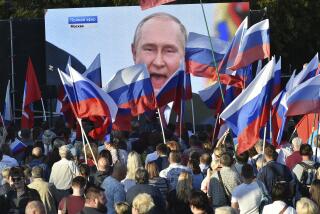An Old Refrain: What Will the Soviets Do? : Diplomacy: Unraveling the enigma of the Soviet Union’s future has been a pastime of statesmen throughout the 20th Century--but now things have changed.
- Share via
NEW HAVEN, CONN. — For the third time in this century, the uncertain course of the Soviet Union commands the attention of the United States and other major governments. No Soviet representative was present at the North Atlantic Treaty Organization summit in London two weeks ago, or the economic gathering in Houston last week, but the agenda in both cities was dominated by the enigma of the Soviet Union’s future.
Mikhail S. Gorbachev, absent, was more important than any head of government present. The two conferences pondered whether the Soviet Union will: collapse, recover and grow strong, be cooperative or hostile. Comparing events today with two past occasions of similar uncertainty reveals some enticing parallels and differences, and suggests how events may unfold.
Today’s uncertainty follows on four decades, coinciding with the Cold War, when the Soviet Union appeared internally rigid and unchangeable. The future of Soviet relations with the non-communist world seemed easy to predict: Next year would be just like this, only more so. Short moments of thaw were followed by a return to grim confrontation and a nuclear-arms race that had no end.
Then came Gorbachev, glasnost , perestroika , an empire suddenly revealed to be on the edge of economic catastrophe, Baltic republics seeking independence, other regions barely under Moscow’s control and a revolution in Soviet foreign policy that ended the Cold War.
In the early stages of this great transformation, hard-line voices in the United States called for the maintenance of unrelenting military and economic pressure. These voices have faded as the Soviet government made concession after concession on arms control, encouraged political freedom in Eastern Europe and tolerated the virtual end of the Warsaw Pact. Yet, when Gorbachev asked for economic aid, the United States and its allies could not agree on a coordinated response. President George Bush offers free advice but is holding back on dollars, pending further reductions in the Soviet military and an end to Moscow’s support of Cuba. At the same time, Bush places great weight on his strong personal relationship with Gorbachev.
A pessimist believing in the repetitiousness of history would predict that little good will follow. Two previous epochs support this.
The first began with the collapse of the czarist empire in 1917, continued through the turbulent months of Alexander F. Kerensky’s provisional government and focused on the Bolshevik Revolution and birth of the Soviet Union. President Woodrow Wilson, then leading the United States into war with Germany, believed overthrowing the czar had transformed Russia into a democracy, a “fit partner” for the United States in remaking the world. He was wrong. Economic aid for the provisional government and teams of advisers did nothing to avert the revolution’s second, more radical, chapter: the Bolshevik seizure of power under Vladimir I. Lenin and the outbreak of civil war.
Lenin made a separate peace with Germany and, denouncing all capitalist governments, created hysterical fears in the West of a consuming Red tide of world revolution. The United States responded in contradictory ways. Wilson tried to communicate secretly with the Bolshevik government, and toyed with the idea of civilizing the new regime with gifts of food and economic and technical aid--contingent on a Soviet willingness to abandon its revolutionary agenda. But the United States also assisted anti-communist forces in the civil war, sending several thousand U.S. troops to join the British, French and Japanese in a half-baked military intervention.
The British, French and Japanese were explicitly hostile and would have strangled the Bolshevik regime in its cradle had they been able. When the war with Germany ended in November, 1918, the Soviet government was excluded from participation in the Paris peace conference and denied an invitation to the League of Nations--as if ostracism would make the regime evaporate. It did not. The Communists themselves ended the first period of uncertainty by winning the civil war and building a brutal, totalitarian government under Josef Stalin.
The next period of uncertainty coincided with World War II. In 1939, Stalin made the notorious pact with Adolf Hitler. But in June, 1941, Hitler broke the pact and invaded the Soviet Union. Many military experts believed that Soviet resistance might crumble before snowfall, but the United States and Britain responded to this uncertainty by sending military aid to keep the Soviet Union in the war and ensure Hitler’s ultimate defeat.
By 1943, it was clear that the Grand Alliance of the Soviet Union, the United States and Great Britain would prevail. Now the uncertainty of the Soviet Union’s future course clouded the prospects for peace. Franklin D. Roosevelt hoped that Stalin would abandon his hostile suspicions of the Western democracies, allow the small countries of Eastern Europe freedom and be a willing partner in shaping a new international system through the United Nations. Roosevelt sought this outcome by attempting to forge a close personal relationship with Stalin, by softening the criticism of Soviet plans for turning Eastern Europe into a belt of satellites and by dangling billions of dollars of aid. Critics, then and now, called Roosevelt an appeaser. Appeasement, or not, his policy did not work.
As the Second World War came to an end, and Harry S. Truman succeeded Roosevelt, uncertainty over the Soviet Union dominated U.S. policy. Those in the government who favored a conciliatory approach toward Moscow resigned or were fired. The potential offer of bilateral aid was withdrawn--although momentarily revived as part of the Marshall Plan on the unlikely condition that the Soviets agree to an open economy. Instead, the Soviets spurned the Marshall Plan as an instrument of U.S. imperialism.
By 1948, uncertainty over the Soviet Union evaporated. Stalin appeared committed to tightening the Soviet grip on Eastern Europe, encouraging subversion in the non-communist world and maintaining military forces for a Third World War. The decades of predictable Cold War rolled on.
But now the future of the Soviet Union is as difficult to predict as it was in 1917 or 1945. We see parallels with the past: faith in personal relationships, the consideration of economic aid, the surge of optimism. Will it all turn sour? In search of the answer we should turn to the differences between past and present. They are profound.
The militant ideology of communism, with its belief in the ultimate destruction of capitalism, is gone. Boris Yeltsin, the second most prominent politician in Russia, has even resigned from the Communist Party. The totalitarian suppression of information about the outside world is over. Soviets can think and speak for themselves as never before. The necessity of relieving the Soviet economy of the burden of huge military expenditures is openly acknowledged and irresistible--as long as other nations are not so foolish as to threaten the Soviet Union militarily.
The Cold War ended for many reasons. The most important and encouraging is the full acceptance, after one last flurry of arms build-up in the early 1980s, of nuclear weapons’ suicidal nature. The danger of nuclear weapons thus has become the functional equivalent of a common enemy. Both sides have revised their nuclear doctrines and reduced the number of weapons. Reduction to perhaps 10% of previous levels is now conceivable. Even when the nuclear danger falls to near zero, the Soviet Union--and the rest of the world--will continue to face the common danger of environmental degradation. A great deal more remains to be done by all governments before the response to the threatened environment is adequate, but the trend is in the right direction.
No one knows whether Gorbachev will stay in power or how quickly, if at all, the Soviet economy can be reformed. The United States and other powerful nations cannot solve internal Soviet problems. But they are reducing uncertainty in the nuclear realm through positive responses to Soviet initiatives, by allaying Soviet fears about the new unified Germany and by rejecting in practice the efficacy of military threats. This kind of uncertainty--on which the well-being of the world depends--is likely to last despite the uncertainty over who will be the Soviet leader next year.
This history of past epochs in the Western and U.S. response to the Soviet enigma is worth studying to grasp how much has truly changed.
More to Read
Sign up for Essential California
The most important California stories and recommendations in your inbox every morning.
You may occasionally receive promotional content from the Los Angeles Times.













